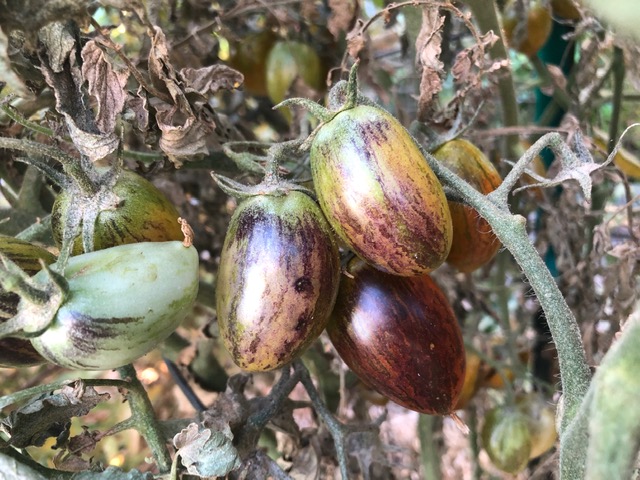
|
|
Look closely to spot the mite damage on this Brad's Atomic Grape tomato plant. It's especially evident around the sepals (green "caps") of the tomatoes. Water is your best weapon against spider mites. (Photo: Kathy Morrison)
|
Hot weather, smoky skies, dusty plants and no rain in sight: That’s paradise for spider mites.
With prolonged dry heat, this summer has seen a spider mite explosion. The itty-bitty arachnids seem to be spinning their webs over everything: Tomatoes, roses, camellias, berries, fruit trees, you name it.
A cousin of spiders, spider mites have built up massive populations in local community gardens as well as backyards. Usually, natural enemies can keep these voracious critters under control. But right now, spider mites are having a baby boom.
Spider mites can produce a whole generation in five to 10 days. Each mama mite can lay 100 eggs. No wonder their numbers can overwhelm a plant in a short time.
Spider mites are so tiny – smaller than the period at the end of this sentence – gardeners usually don’t notice them until they’re mature; that’s when they start spinning their telltale webs.
As they grow, they tend to hide out on the underside of foliage, practically invisible to even the most observant gardeners. Spider mite feeding may cause polka-dot stippling to appear on leaves.
According to the UC Cooperative Extension master gardeners, spider mites attack many fruit trees, shrubs, vines, berries, vegetables and other ornamental plants. Besides tomatoes and roses, they also love beans, grapevines, squash and melons.
The damage at first looks a little like peach leaf curl with foliage developing stipples and turning yellow or red before falling off. Then the webs start appearing, coating leaves and stems.
If left undisturbed, spider mites can overwhelm plants. They’re especially bad during drought conditions (like right now) and can do the most harm to water-stressed plants.
Spider mites can’t be controlled by insecticides – they’re not an insect, they’re a mite. But miticides are not recommended either, since they kill many beneficial insects in addition to the mites, which often manage to evade pesticide sprays.
Neem oil applied in the early stages of an infestation may smother the mites, but also kills beneficial insects including those that eat mites. In addition, neem oil sprayed on hot days can cook the plant’s foliage – eliminating any benefit.
Instead of neem oil or miticides, grab a hose and make it “rain.” Spider mites are proliferating because of lack of rain and resulting dusty, dry conditions on plants. Washing down foliage mimics a summer storm and disrupts the mites’ happy homes.
Insecticidal soap also can be helpful if applied at the first signs of trouble. Make sure to spray the underside of leaves, too.
The good news? Spider mites usually die out in September when their natural enemies can keep their numbers in check. Until then, keep giving plants a gentle morning shower as needed to wash dust and mites away.
For more advice, see the UC IPM pest notes on spider mites:
http://ipm.ucanr.edu/PMG/PESTNOTES/pn7405.html
